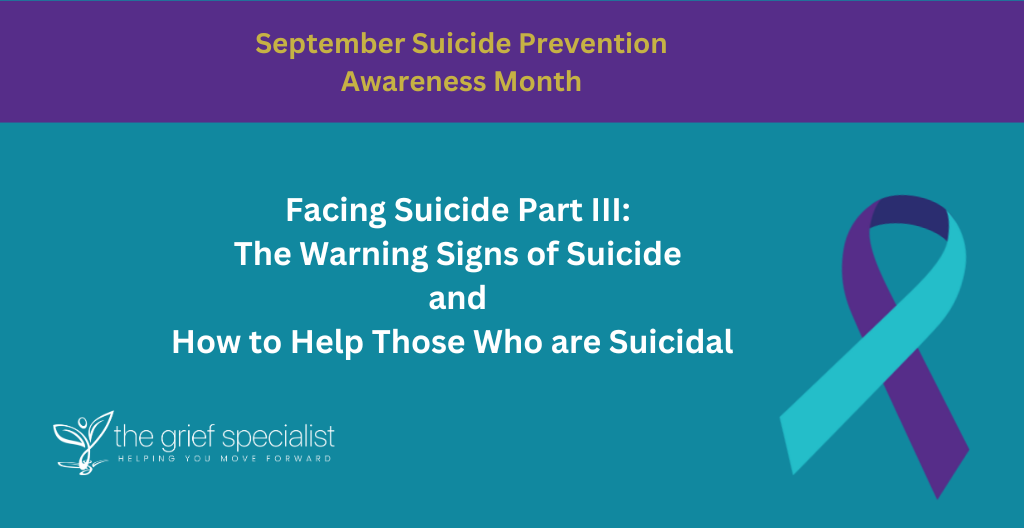In Parts I and II of Facing Suicide, I shared with you some important information and statistics about suicide. You learned about who dies by suicide, what suicide is, when it happens, where it occurs, and how people do it. I did my best to help you understand why your loved one chose suicide. While this question will remain unanswered, it is my hope that learning about suicide has helped you be in your loved one’s shoes and understand their pain and suffering. This week, I want you to learn the warning signs of suicide and how to help those who are suicidal. If you want Parts I and II emailed to you, please register on https://www.theegriefspecialist.com for Thursday Thoughts. I will send them to you.
Suicide has devastating effects on friends, family members and loved ones that can be severe, long-lasting, and far reaching. Suddenly we are now suicide loss survivors – a title we prefer not to own.
Suicide has touched my family multiple times. My 16-year-old niece was diagnosed with bi-polar disorder – a mental health disease. She was on suicide watch, however she managed to get out from under the careful eye of those taking care of her. My second daughter’s best friend and high school classmate chose suicide – for reasons I do not know. My 24-year-old son had many of the same problems a man his age might experience, getting established in his career, grounding himself financially and finding the relationship he was seeking. He had a relapse in his alcohol and drug use. It is possible that the combination of his life circumstances and recent relapse was the cause of his pain being too great to bear. My son sprinkled some warning signs amongst some friends and family members that he was considering taking his life, yet it was nothing that at the time raised red flags. It was only after his death that the pieces came together. My brother took his life after being severely depressed for many years. His family encouraged him to get help, yet he chose not to do so. Was it pride, ego, shame, or guilt on his part as a 65-year-old man that prevented him from getting help? He never spoke about wanting to die.
Suicide is complex, tricky, and complicated and leaves those bereaved by suicide scratching their heads as to the reasons our loved ones take their lives.
There are warning signs to be aware of – however, based on my experience, they are not all inclusive and each person’s signs are unique. According to the National Institute of Mental Health website, the behaviors listed below are a starting point in determining if someone is considering suicide:
Talking About:
- Wanting to die.
- Great guilt or shame.
- Being a burden to others.
Feeling:
- Empty, hopeless, trapped or having no reason to live.
- Extremely sad, more anxious, agitated, or full of rage.
- Unbearable emotional or physical pain.
Changing Behavior, such as:
- Making a plan or researching ways to die.
- Withdrawing from friends, saying goodbye, giving away important items or making a will.
- Taking dangerous risks such as driving extremely fast.
- Displaying extreme mood swings.
- Eating or sleeping more or less.
- Using drugs or alcohol more often.
The above list are signs for you to be looking for in others. If you believe someone is suicidal, you can follow the guidelines below. Questions and suggestions courtesy of Western Michigan University website wmich.edu.
How do we Help Those we Believe are Suicidal?
- Recognize the warning signs from the above list.
- Take suicidal statements seriously and trust your gut instinct.
- Get involved with them and use “active” listening.
- Tell the person you are concerned.
- Do not attempt to argue them out of suicide.
- Help them to understand they are loved and not alone.
- Encourage them to seek professional help.
- Help them find help.
- Offer to go with them to appointments.
Ask Questions
- Be direct and ask, “Do you feel so badly that you are thinking about suicide?”
- If the answer is yes, continue to ask the following “Suicide Risk” assessment questions:
- “Do you have a plan to take your own life?” or “Have you thought of how you would do it?”
- “Do you have the means or materials available to act out your plan?” If so, “What are they? Where are they?”
- “Have you set a time?” or Have you decided when you would do it?”
- If the answer is still “Yes,” ask:
- “Have you attempted suicide before?”
- “What happened then?”
- If they answer yes to having a plan, means and time set, the person should be considered high risk for suicide. They should not be left alone.
- Remove harmful items and get help.
Additional Suggestions
- Be direct. Talk openly and matter-of-factly about suicide.
- Be non-judgmental.
- Don’t debate whether suicide is right or wrong, or whether feelings are good or bad.
- Don’t lecture on the value of life.
- Get involved. Become available. Show interest and support.
- Don’t dare him or her to do it.
- Don’t ask “why.” This encourages defensiveness.
- Offer empathy, not sympathy.
- Never promise to keep suicide a secret. Seek support.
- Offer hope that alternatives are available but do not offer glib reassurance.
- Do not counsel the person yourself, seek professional help.
- Don’t pretend you have all the answers. The most important thing you can do may be to help them find help.
- Don’t be afraid of being wrong.
It is difficult for even experts to understand who is at serious risk of suicide and who is not. Many of the warning signs for suicide could also indicate problems with drug or alcohol abuse, domestic violence, depression, or another mental illness, which still need professional intervention.
Learning how to recognize warning signs of suicide is extremely valuable. Asking direct questions is something you are most likely not comfortable with. However, when asked in a sincere, kind and loving manner, you can help someone get help they so desperately need. Become familiar with the questions, post this email somewhere you can see it and be prepared at any time or any place to use them.
Next week, in Part IV, you will learn the impact the death of someone you love to suicide has on you. This made a difference for one of my friends who watched my journey on Facebook after my son died. You can read her message to me in next week’s blog.
Together, we will travel through Suicide Awareness and Prevention month. Will you do me a favor? Share this five-part series with at least 2 people each week. Better yet, share this link, Home – The Grief Specialist so they can register to start receiving Thursday Thoughts in their inbox.
You could change a life.
Peggy
#helpingyoumoveforward
#suicideprevention
#resilience
#suicidelosssurvivor
#mentalhealthhelp
#suicidewarningsigns




